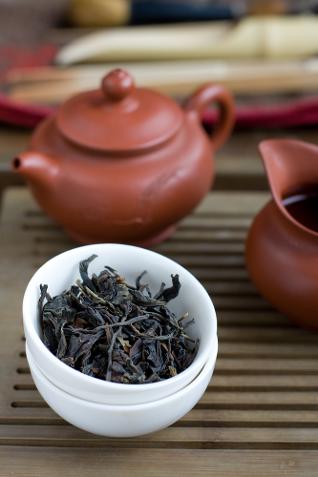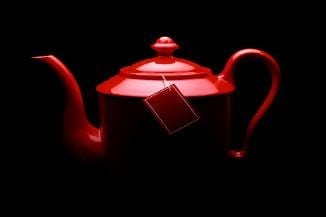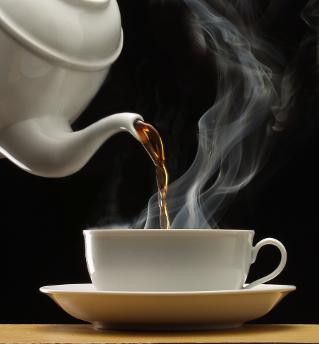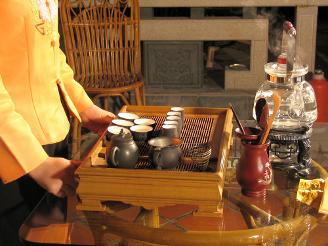The traditional method of making or brewing a cup of tea is to place loose tea leaves, either directly or in a tea infuser, into a tea pot or tea cup
and pour freshly boiled water over the leaves. After a few minutes, the leaves are usually removed again, either by removing the infuser, or by straining the tea while serving.
Water plays an important role in the quality of the final cup. Filtered water that doesn’t have any residual chlorine smell is usually best, whilst distilled water would be bad as it contains no minerals.
 Most green teas should be allowed to steep for about two or three minutes, although some types of tea require as much as ten minutes, and others as little as 30 seconds. The strength of the tea should be varied by changing the amount of tea leaves used, not by changing the steeping time. The amount of tea to be used per amount of water differs from tea to tea, but one basic recipe may be one slightly heaped teaspoon of tea (about 5 ml) for each teacup of water (200–240 ml) (7–8 oz) prepared as above. Stronger teas, such as Assam, to be drunk with milk, are often prepared with more leaves, and more delicate high-grown teas such as a Darjeeling are prepared with somewhat fewer (as the stronger mid-flavors can overwhelm the champagne notes).
Most green teas should be allowed to steep for about two or three minutes, although some types of tea require as much as ten minutes, and others as little as 30 seconds. The strength of the tea should be varied by changing the amount of tea leaves used, not by changing the steeping time. The amount of tea to be used per amount of water differs from tea to tea, but one basic recipe may be one slightly heaped teaspoon of tea (about 5 ml) for each teacup of water (200–240 ml) (7–8 oz) prepared as above. Stronger teas, such as Assam, to be drunk with milk, are often prepared with more leaves, and more delicate high-grown teas such as a Darjeeling are prepared with somewhat fewer (as the stronger mid-flavors can overwhelm the champagne notes).
The best temperature for brewing tea depends on its type. Teas that have little or no oxidation period, such as a green or white tea, are best brewed at lower temperatures, between 65 and 85 °C (149 and 185 °F), while teas with longer oxidation periods should be brewed at higher temperatures around 100 °C (212 °F). The higher temperatures are required to extract the large, complex, flavorful phenolic molecules found in fermented tea. In addition, boiling reduces the dissolved oxygen content of water. Dissolved oxygen would otherwise react with phenolic molecules to turn them brown and reduce their potency as antioxidants. To preserve the antioxidant potency, especially for green and white teas brewed at a lower temperature, water should be boiled vigorously to boil off any dissolved oxygen and then allowed to cool to the appropriate temperature before adding to the tea.
Some green, white and oolong teas are often brewed several times using the same leaves. Historically in China, tea is divided into a number of infusions. The first infusion is immediately poured out to wash the tea, and then the second and further infusions are drunk. The third through fifth are nearly always considered the best infusions of tea, although different teas open up differently and may require more infusions of hot water to produce the best flavor.
 One way to taste a tea, throughout its entire process, is to add hot water to a cup containing the leaves and after about 30 seconds to taste it. As the tea leaves unfold (known as “The Agony of the Leaves”), they give up various parts of themselves to the water and thus the taste evolves. Continuing this from the very first flavours to the time beyond which the tea is quite stewed will allow an appreciation of the tea throughout its entire length.
One way to taste a tea, throughout its entire process, is to add hot water to a cup containing the leaves and after about 30 seconds to taste it. As the tea leaves unfold (known as “The Agony of the Leaves”), they give up various parts of themselves to the water and thus the taste evolves. Continuing this from the very first flavours to the time beyond which the tea is quite stewed will allow an appreciation of the tea throughout its entire length.
Serving
To preserve the pre tannin tea without requiring it all to be poured into cups, a second teapot may be used. The steeping pot is best unglazed earthenware; Yixing pots are the best known of these, famed for the high quality clay from which they are made. The serving pot is generally porcelain, which retains the heat better. Larger teapots are a post-19th century invention, as tea before this time was very rare and very expensive. Experienced tea-drinkers often insist the tea should not be stirred around while it is steeping (sometimes called winding or mashing in the UK). This, they say, will do little to strengthen the tea, but is likely to bring the tannins out in the same way that brewing too long will do. For the same reason, one should not squeeze the last drops out of a teabag; if stronger tea is desired; more tea leaves should be used.
The addition of milk to tea in Europe was first mentioned in 1680 by the epistolist Madame de Sevigne. Many teas are traditionally drunk with milk in cultures where dairy products are consumed. These include Indian masala chai and British tea blends. These teas tend to be very hearty varieties of black tea which can be tasted through the milk, such as Assams, or the East Friesian blend. Milk is thought to neutralize remaining tannins and reduce acidity. The Han Chinese do not usually drink milk with tea (or indeed use milk at all) but the Manchus do, and the elite of the Quing Dynasty of the Chinese Empire continued to do so. Hong Kong style milk tea is based on British colonial habits. Tibetans and other Himalayan peoples traditionally drink tea with milk or yak butter and salt. In Eastern European countries (Russia, Poland and Hungary) and in Italy, tea is commonly served with lemon juice. In Poland, tea with milk is called a bawarka (“Bavarian style”), and is often drunk by pregnant and nursing women.
The order of steps in preparing a cup of tea is a much-debated topic, and can vary widely between cultures or even individuals. Some say it is preferable to add the milk before the tea, as the high temperature of freshly brewed tea can denature the proteins found in fresh milk, similar to the change in taste, resulting in an inferior-tasting beverage. Others insist it is better to add the milk after brewing the tea, as most teas need to be brewed as close to boiling as possible. The addition of milk chills the beverage during the crucial brewing phase, if brewing in a cup rather than using a pot, meaning the delicate flavor of a good tea cannot be fully appreciated. By adding the milk afterwards, it is easier to dissolve sugar in the tea and also to ensure the desired amount of milk is added, as the colour of the tea can be observed. Historically, the order of steps was taken as an indication of class: only those wealthy enough to afford good-quality porcelain would be confident of its being able to cope with being exposed to boiling water unadulterated with milk.
 Many flavourings are added to varieties of tea during processing. Among the best known are Chinese jasmine tea, with jasmine oil or flowers, the spices in Indian masala chai, and Earl Grey tea, which contains oil of bergamot. A great range of modern flavours have been added to these traditional ones. In eastern India, people also drink lemon tea or lemon masala tea. Lemon tea simply contains hot tea with lemon juice and sugar. Masala lemon tea contains hot tea with roasted cumin seed powder, lemon juice, black salt and sugar, which gives it a tangy, spicy taste. Adding a piece of ginger when brewing tea is a popular habit of Sri Lankans, who also use other different types of spices such as cinnamon to sweeten the aroma.
Many flavourings are added to varieties of tea during processing. Among the best known are Chinese jasmine tea, with jasmine oil or flowers, the spices in Indian masala chai, and Earl Grey tea, which contains oil of bergamot. A great range of modern flavours have been added to these traditional ones. In eastern India, people also drink lemon tea or lemon masala tea. Lemon tea simply contains hot tea with lemon juice and sugar. Masala lemon tea contains hot tea with roasted cumin seed powder, lemon juice, black salt and sugar, which gives it a tangy, spicy taste. Adding a piece of ginger when brewing tea is a popular habit of Sri Lankans, who also use other different types of spices such as cinnamon to sweeten the aroma.
Other popular additives to tea by the tea-brewer or drinker include sugar, liquid honey or a solid Honey Drop, agave nectar, fruit jams, and mint. In China, sweetening tea was traditionally regarded as a feminine practice. In colder regions, such as Mongolia, Tibet and Nepal, butter is added to provide necessary calories. Tibetan butter tea contains rock salt and dre (yak) butter, which is then churned vigorously in a cylindrical vessel closely resembling a butter churn. The same may be said for salt tea, which is consumed in some cultures in the Hindu Kush region of northern Pakistan.
ALCOHOL, SUCH AS WHISKEY OR BRANDY,
MAY ALSO BE ADDED TO TEA.
 The flavor of the tea can also be altered by pouring it from different heights, resulting in varying degrees of aeration. The art of high-altitude pouring is used principally by people in Northern Africa (e.g. Morocco, Algeria, Mauritania and Libya), but also in West Africa (e.g. Guinea, Mali and Senegal) and can positively alter the flavour of the tea, but it is more likely a technique to cool the beverage destined to be consumed immediately. In certain cultures, the tea is given different names depending on the height from which it is poured. In Mali, gunpowder tea is served in series of three, starting with the highest oxidization or strongest, unsweetened tea (cooked from fresh leaves), locally referred to as “strong like death”, followed by a second serving, where the same tea leaves are boiled again with some sugar added (“pleasant as life”), and a third one, where the same tea leaves are boiled for the third time with yet more sugar added (“sweet as love”). Green tea is the central ingredient of a distinctly Malian custom, the “Grin”, an informal social gathering that cuts across social and economic lines, starting in front of family compound gates in the afternoons and extending late into the night, and is widely popular in Bamako and other large urban areas.
The flavor of the tea can also be altered by pouring it from different heights, resulting in varying degrees of aeration. The art of high-altitude pouring is used principally by people in Northern Africa (e.g. Morocco, Algeria, Mauritania and Libya), but also in West Africa (e.g. Guinea, Mali and Senegal) and can positively alter the flavour of the tea, but it is more likely a technique to cool the beverage destined to be consumed immediately. In certain cultures, the tea is given different names depending on the height from which it is poured. In Mali, gunpowder tea is served in series of three, starting with the highest oxidization or strongest, unsweetened tea (cooked from fresh leaves), locally referred to as “strong like death”, followed by a second serving, where the same tea leaves are boiled again with some sugar added (“pleasant as life”), and a third one, where the same tea leaves are boiled for the third time with yet more sugar added (“sweet as love”). Green tea is the central ingredient of a distinctly Malian custom, the “Grin”, an informal social gathering that cuts across social and economic lines, starting in front of family compound gates in the afternoons and extending late into the night, and is widely popular in Bamako and other large urban areas.
TEA STORAGE INSTRUCTIONS
Tea shelf life varies with storage conditions and type of tea. Black tea has a longer shelf life than green tea. An exception, pu-erh tea, improves with age. Tea stays freshest when stored in a dry, cool, dark place in an air-tight container. Black tea stored in a bag inside a sealed opaque canister may keep for two years. Green tea loses its freshness more quickly, usually in less than a year. Gunpowder tea, its leaves being tightly rolled, keeps longer than the more open-leafed Chun Mee.
Improperly stored tea may lose flavor, acquire disagreeable flavors or odors from other foods, or become moldy.
